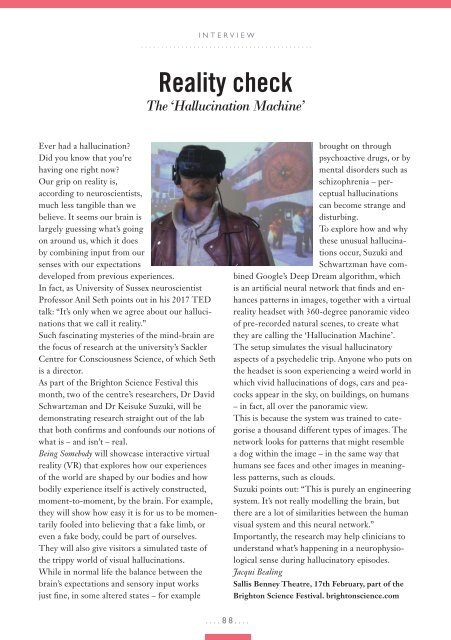Viva Brighton Issue #60 February 2018
You also want an ePaper? Increase the reach of your titles
YUMPU automatically turns print PDFs into web optimized ePapers that Google loves.
INTERVIEW<br />
...........................................<br />
Reality check<br />
The ‘Hallucination Machine’<br />
Ever had a hallucination?<br />
Did you know that you’re<br />
having one right now?<br />
Our grip on reality is,<br />
according to neuroscientists,<br />
much less tangible than we<br />
believe. It seems our brain is<br />
largely guessing what’s going<br />
on around us, which it does<br />
by combining input from our<br />
senses with our expectations<br />
developed from previous experiences.<br />
In fact, as University of Sussex neuroscientist<br />
Professor Anil Seth points out in his 2017 TED<br />
talk: “It’s only when we agree about our hallucinations<br />
that we call it reality.”<br />
Such fascinating mysteries of the mind-brain are<br />
the focus of research at the university’s Sackler<br />
Centre for Consciousness Science, of which Seth<br />
is a director.<br />
As part of the <strong>Brighton</strong> Science Festival this<br />
month, two of the centre’s researchers, Dr David<br />
Schwartzman and Dr Keisuke Suzuki, will be<br />
demonstrating research straight out of the lab<br />
that both confirms and confounds our notions of<br />
what is – and isn’t – real.<br />
Being Somebody will showcase interactive virtual<br />
reality (VR) that explores how our experiences<br />
of the world are shaped by our bodies and how<br />
bodily experience itself is actively constructed,<br />
moment-to-moment, by the brain. For example,<br />
they will show how easy it is for us to be momentarily<br />
fooled into believing that a fake limb, or<br />
even a fake body, could be part of ourselves.<br />
They will also give visitors a simulated taste of<br />
the trippy world of visual hallucinations.<br />
While in normal life the balance between the<br />
brain’s expectations and sensory input works<br />
just fine, in some altered states – for example<br />
brought on through<br />
psychoactive drugs, or by<br />
mental disorders such as<br />
schizophrenia – perceptual<br />
hallucinations<br />
can become strange and<br />
disturbing.<br />
To explore how and why<br />
these unusual hallucinations<br />
occur, Suzuki and<br />
Schwartzman have combined<br />
Google’s Deep Dream algorithm, which<br />
is an artificial neural network that finds and enhances<br />
patterns in images, together with a virtual<br />
reality headset with 360-degree panoramic video<br />
of pre-recorded natural scenes, to create what<br />
they are calling the ‘Hallucination Machine’.<br />
The setup simulates the visual hallucinatory<br />
aspects of a psychedelic trip. Anyone who puts on<br />
the headset is soon experiencing a weird world in<br />
which vivid hallucinations of dogs, cars and peacocks<br />
appear in the sky, on buildings, on humans<br />
– in fact, all over the panoramic view.<br />
This is because the system was trained to categorise<br />
a thousand different types of images. The<br />
network looks for patterns that might resemble<br />
a dog within the image – in the same way that<br />
humans see faces and other images in meaningless<br />
patterns, such as clouds.<br />
Suzuki points out: “This is purely an engineering<br />
system. It’s not really modelling the brain, but<br />
there are a lot of similarities between the human<br />
visual system and this neural network.”<br />
Importantly, the research may help clinicians to<br />
understand what’s happening in a neurophysiological<br />
sense during hallucinatory episodes.<br />
Jacqui Bealing<br />
Sallis Benney Theatre, 17th <strong>February</strong>, part of the<br />
<strong>Brighton</strong> Science Festival. brightonscience.com<br />
....88....


















